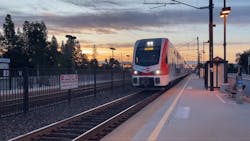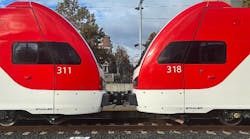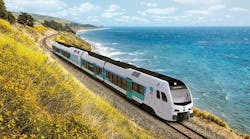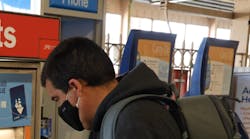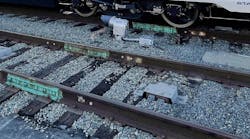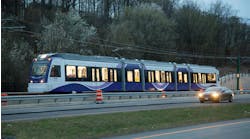In the process of electrifying its system, Caltrain has successfully tested electric trains and overhead wires between Redwood City and Mountain View, Calif., for the first time. This will allow the agency to ramp up the testing of the new fleet before the launch of its electrified service in fall 2024.
Live run tests started at 20 miles per hour, to ensure the overhead wire and train are properly connected. Once the connection was successfully established, the train increased speed to the corridor’s 79 mph maximum limit and 25 such test runs were successfully completed over a weekend.
Each of the 23 electric trainsets must complete 1,000 miles of testing before it can carry passengers. Initial tests were conducted between Santa Clara and College Park Stations on the Santa Clara Drill Track but Caltrain has steadily been expanding the available testing area from San Jose to Mountain View. With this live run, testing can now take place from San Jose to Redwood City, further accelerating the process and keeping the launch of service on schedule.
“Another test completed marks another step towards a reliable, fast and frequent service for our riders,” said Caltrain Executive Director Michelle Bouchard. “I cannot wait for everyone to get to experience the modernized, zero-emission fleet of Caltrain’s future for themselves this fall.”
Caltrain’s historic Electrification Project is the first undertaking in North America in a generation in which diesel trains and their infrastructure components are transitioned to an electrified system. Electrification means faster and more frequent service, including doubling the frequency on weekends. Caltrain notes the passenger experience will be greatly improved as well, with the new trains featuring Wi-Fi, power outlets at every seat, onboard displays with digital trip information and increased storage capacities.
Electrification will also help meet regional and state climate action goals by lowering greenhouse gas emissions, improving air quality and relieving traffic congestion. Additionally, electrified service will advance equity along the corridor by reducing noise and air pollution while increasing access for priority equity communities. It will also set the framework for California’s future high-speed rail network that will run on the Caltrain corridor.
The proposed electrification service plan includes 70 weekday peak hour trains, an increase from the current 66. Eleven stations would see four train arrivals hourly per direction, up from seven stations currently. Midday trains would cover 44 stations per hour, up from 34 a day and weekend service will arrive every half hour, rather than hourly.
